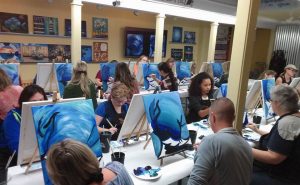They are actually almost vegetarian!
http://www.zmescience.com/ecology/animals-ecology/myth-buster-bears-not-ferocious-flesh-eaters/
They are actually almost vegetarian!
http://www.zmescience.com/ecology/animals-ecology/myth-buster-bears-not-ferocious-flesh-eaters/
Clay Henderson, Executive Director of the Stetson University Institute for Water and Environmental Resilience, discusses the water issues facing
*Breaking News*
Senator Dana Young (R) of Tampa has filed a bill to ban fracking in Florida!
“I believe, and it is the belief of most Floridians, that our fragile limestone geology and fragile environment as a whole is incompatible with fracking of any kind. So it’s a balancing act.”
Read more here: http://www.bradenton.com/…/politics-…/article128368889.html…
—–Fun Fact—-
Did you know that bears bite off their foot pads in the winter?!
They grow fresh foot pads so they won’t have callouses.
It’s like a mani-pedi for bears!
So many hearts to touch. So many minds to change. Will you volunteer with us?
Imperiled Species Management Plan rule changes are in effect
Florida Fish and Wildlife Conservation Commission
(Having trouble viewing this email? View it as a Web page.)
Jan. 18, 2017
Suggested Tweet: Imperiled Species Management Plan rule changes in effect. @MyFWC: https://content.govdelivery.com/accounts/…/bulletins/18133ff #Florida #wildlife
The Imperiled Species Management Plan rule changes are now in effect, including changes in listing status for many species. The Florida Fish and Wildlife Conservation Commission (FWC) approved the groundbreaking plan in an effort to achieve conservation success with dozens of imperiled species throughout the state. The plan outlines the steps to conserve 57 species along with the broader vision of restoring habitats essential to the long-term survival of multiple fish and wildlife species.
“Florida is charting an ambitious new path for wildlife conservation success on a statewide scale,” said FWC Chairman Brian Yablonski. “Seeing a roseate spoonbill wading in shallow waters, a black skimmer resting on the beach or a Big Cypress fox squirrel sitting in a pine tree is an essential part of the Florida experience. This innovative plan is designed to keep imperiled species like these around for many generations to come.”
Nine rules were revised in support of the ISMP, focusing on changes to listing status, adding authorizations in a management plan or Commission-approved guidelines, preventing possession of species coming off the list, and accomplishing overall rule cleanup and clarification. Among the nine rules, one rule affecting inactive nests of non-listed birds is still pending.
Under the rule change that updates species’ listing status:
Fifteen species will no longer be listed as imperiled species because conservation successes improved their status: eastern chipmunk, Florida mouse, brown pelican, limpkin, snowy egret, white ibis, peninsula ribbon snake (lower Keys population), red rat snake (lower Keys population), striped mud turtle (lower Keys population), Suwannee cooter, gopher frog, Pine Barrens tree frog, Lake Eustis pupfish, mangrove rivulus and Florida tree snail. These species still are included in the plan for guidance in monitoring and conserving them.
Twenty-three species are newly listed as state Threatened species, a change from their former status as Species of Special Concern: Sherman’s short-tailed shrew, Sanibel rice rat, little blue heron, tricolored heron, reddish egret, roseate spoonbill, American oystercatcher, black skimmer, Florida burrowing owl, Marian’s marsh wren, Worthington’s marsh wren, Scott’s seaside sparrow, Wakulla seaside sparrow, Barbour’s map turtle, Florida Keys mole skink, Florida pine snake, Georgia blind salamander, Florida bog frog, bluenose shiner, saltmarsh top minnow, southern tessellated darter, Santa Fe crayfish and Black Creek crayfish. Threatened species have populations that are declining, have a very limited range or are very small.
Fourteen species keep their state Threatened status: Everglades mink, Big Cypress fox squirrel, Florida sandhill crane, snowy plover, least tern, white-crowned pigeon, southeastern American kestrel, Florida brown snake (lower Keys population), Key ringneck snake, short-tailed snake, rim rock crowned snake, Key silverside, blackmouth shiner and crystal darter.
Five species remain Species of Special Concern: Homosassa shrew, Sherman’s fox squirrel, osprey (Monroe County population), alligator snapping turtle and harlequin darter. These species have significant data gaps, and the FWC plans to make a determination on their appropriate listing status in the near future.
Important things to know about the Imperiled Species Management Plan:
It includes one-page summaries for each species, including a map of its range in Florida and online links to Species Action Plans. The 49 Species Action Plans contain specific conservation goals, objectives and actions for all 57 species.
It also has Integrated Conservation Strategies that benefit multiple species and their habitats, and focus implementation of the plan on areas and issues that yield the greatest conservation benefit for the greatest number of species.
Learn more about the plan at MyFWC.com/Imperiled.
Imagine Our Florida is more than grateful to our sponsors, Marie and Matthew from SeaLife Aquarium in Apopka. Your friendship and support are valued by all of us at IOF.
Recently, we submitted a proposal to Google with a vision of getting wildlife crossing alerts on the google map app.
Sabal Trails Gopher Tortoise Turmoil
A recently released bi-weekly report on the Sabal Trail pipeline demonstrated some insight on the ecological effects of the gopher tortoise in the area. The report Docket No. CP15-17-000 stated the following:
●Spread 3, Georgia, a total of 4 burrows were investigated and eliminated and 2 gopher tortoises were captured and excluded from the workspace.
● Spread 3, Florida, 80 burrows investigated, 43 excavated, and 20 tortoises relocated.
●Spread 4, 135 burrows were investigated, 103 excavated, and 35 gopher tortoises were captured and excluded from the workspace.
● Spread 5, 602 burrows were investigated, 369 excavated, and 153 gopher tortoises were captured and excluded from the workspace.
●Spread 6, excavations continue, 20 burrows were investigated, 15 excavated, and 7 gopher tortoises were excluded or relocated.” Is there a reason the remaining tortoises are not being relocated?
Imagine Our Florida, Inc. contacted FWC regarding the information in the document. The response was as follows:
“I am happy to answer your question, but would like to know what report you are referring to in your request below since it is not from a FWC report. Knowing the source and dates of your information will be helpful! Also the reports to FWC are not yet submitted, but I am told that the Authorized Gopher Tortoise Agent is working on entering the data this week. So we may not have the info you are asking about right now. This information contained in the gopher tortoise permits are viewable/searchable by the public online at http://myfwc.com/gophertortoise/permitting. See attached for an overview of the FWC permit system.
As I noted previously we do not yet have reports from ST about the relocation that has occurred. However, I was able to obtain clarification regarding the data in the FERC report. The burrows investigated included all gopher tortoise burrows that had been documented during any of the previous tortoise burrow surveys. Some of those burrows had either become abandoned or were no longer intact burrows. The remainder of the non-excavated burrows ether occurred outside of the pipeline work area corridor or were just at the edge and going off-site; those burrows were excluded from the corridor work area with silt fencing. They only excavated and relocated tortoises could not be excluded, and were in the right of way, resulting in the difference of numbers of burrows v. excavated v. tortoises.
Once the report is entered into the online permit system, you will be able to access the tortoise data from that system. Please let
me know if you have any further questions on this project.”
With the numbers previously documented compared to those recently found it would appear there has already been a reduction in the population. Following the message we asked if there be any follow-up research to determine the actual impact of this project on the tortoises?
“Each tortoise will use multiple burrows over the course of a season or year, but each burrow does not typically host multiple tortoises. The average occupancy rate for gopher tortoise burrows is 50%, but that rate fluctuates per site. On sections of the corridor, the occupancy rate was lower, which is not uncommon, as rates can range from 30%-70% depending on habitat conditions and soils. Therefore the number of burrows does not indicate the population size. There was no evidence of mortality and the population appears healthy.
We partnered with UCF and Sabal Trail on a research project at Halpata Preserve associated with temporary exclusion of tortoises from the right of way corridor, and the UCF researcher will complete this study next fall. We have issued permits for the temporary exclusion (v. permanent relocation to another site) for many years and will learn more about the tortoises re-homing ability back to the corridor once the exclusion fencing is removed. Regardless of the study, temporary displacement is much preferred over permanent relocation as typically done with development projects since the habitat will be available to tortoises again after the pipeline project is completed. This also helps keep the resident population intact and minimizes stress to the animals cause by longer translocations.”
One study identified 31-68% occupancy rates throughout pine forests in Florida. (Ashton, 2008) With survival rates at only 5.8% (Auffenberg, 1969) due to predation. With odds such as these every effort should be taken to reduce threats to this already threatened species. Perhaps we need to take a step back and ask ourselves if projects such as these are really even necessary. Given the number of pipeline incidents have increased from 381 in 1996 to 715 in 2015 is would seem we should be using more modern technology and steer clear of these incidents in the future. On the brighter side, the number of fatalities appears to have dropped from 53 in 1996 to 10 in 2015 with a total of 347 deaths overall in the past 20 years. Add in the overall 1,346 injuries and that is a deal breaker for many of us. For others, perhaps the average cost of these incidents at the amount of $342,970,468 annually might be a more pressing matter. Is it really worth the risk to humans, wildlife, or tax payers?
Auffenberg, W. 1969. Tortoise behavior and survival. Rand McNally, Chicago, IL.
Ashton, Ray E.; Ashton, Patricia Sawyer. 2008. The natural history and management of the gopher tortoise Gopherus polyphemus (Daudin). Malibar, FL: Krieger Publishing Company. 275 p. [73126]
http://www.fwspubs.org/doi/suppl/10.3996/062015-JFWM-055/suppl_file/062015-jfwm-055.s7.pdf?code=ufws-site
https://www.fs.fed.us/database/feis/animals/reptile/gopo/all.html
https://etd.auburn.edu/bitstream/handle/10415/1024/Beauman_Richard_19.pdf?sequence=1
Aymee, a director of IOF, had an amazing turnout at the Painting with a Twist fundraiser in St. Pete. Imagine Our Florida Inc. would love to thank all who attended and had a great time while giving back to an amazing charity who is educating, protecting and preserving Florida’s wildlife, natural resources and land. A big Thank you goes to Painting with a Twist in St Pete. who made this all possible. 


Sleepy Creek Lands, previously known as Adena Springs Ranch, currently has approval to withdraw 1.46 million gallons per day from our springs. Sleepy Creek is requesting an additional 1.22 million gallons per day for pasture irrigation, crop irrigation, livestock use and commercial/industrial use.
The St. Johns River Management District Governing Board is meeting in Palatka on Tuesday, January 10th to discuss this matter.
Read more in this 2014 article at the Ocala Star Banner: http://www.ocala.com/…/adenasleepy-creek-ruling-a-watershed…
and in this more current Ocala Star Banner article:
http://www.ocala.com/…/st-johns-staff-urges-approval-of-sle…
Make Your Voice Heard.
Click on the link below then under Public input, click to submit your comment.
http://www.sjrwmd.com/facts/AdenaSpringsRanchCUP.html
—-It’s COLD Outside – How do our Bears Stay Warm?—-
As we know, in the fall, our bears foraged in the forests and some in our trash cans, for foods high in carbohydrates and protein. During this stage of hyperphagia, our bears got fat! Many of our Florida Black Bears, including mother bears who will give birth to cubs next month, are denning. Their deep layer of fat and their fur will keep them warm and snugly in their dens. This warmth allows them to wake easily if disturbed.
There’s more! During this denning period, bears get all the water they need from the break down of fat. Their protein comes from muscle and tissue breakdown. The bear’s bodies miraculously use the nitrogen in urea, which is found in their urine, to make new protein.
During Florida cold snaps, we humans layer our clothes, sit by fires, curl up in blankets, make warm comfort food and sip hot drinks. Our incredible bears simply sleep right through it!
http://www.pbs.org/…/na…/bear-essentials-of-hibernation.html
http://www.wec.ufl.edu/…/Garrison%20et%20al%202012%20black%…
Recent Comments